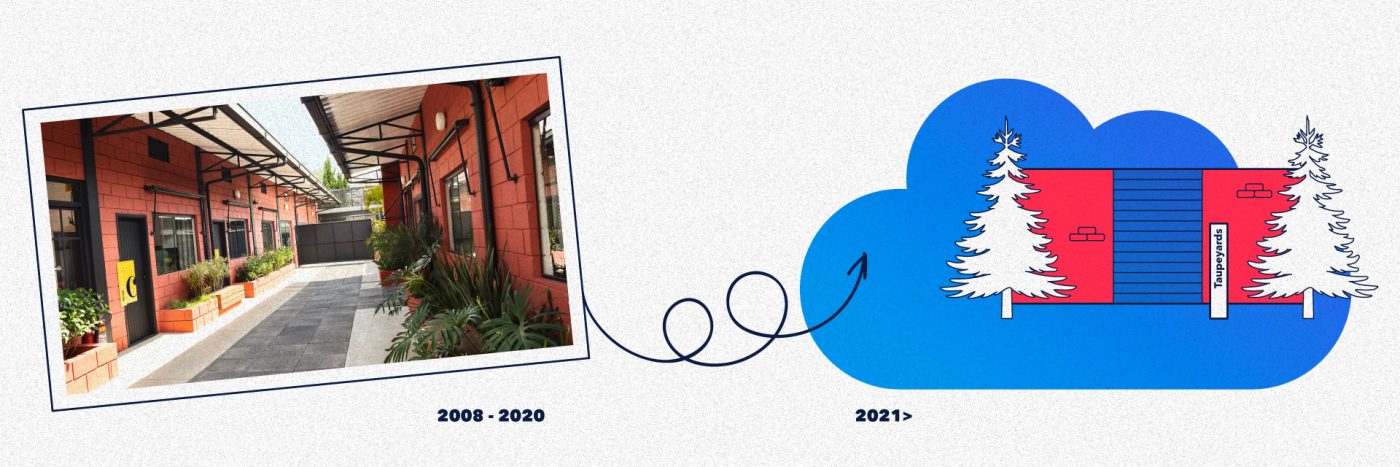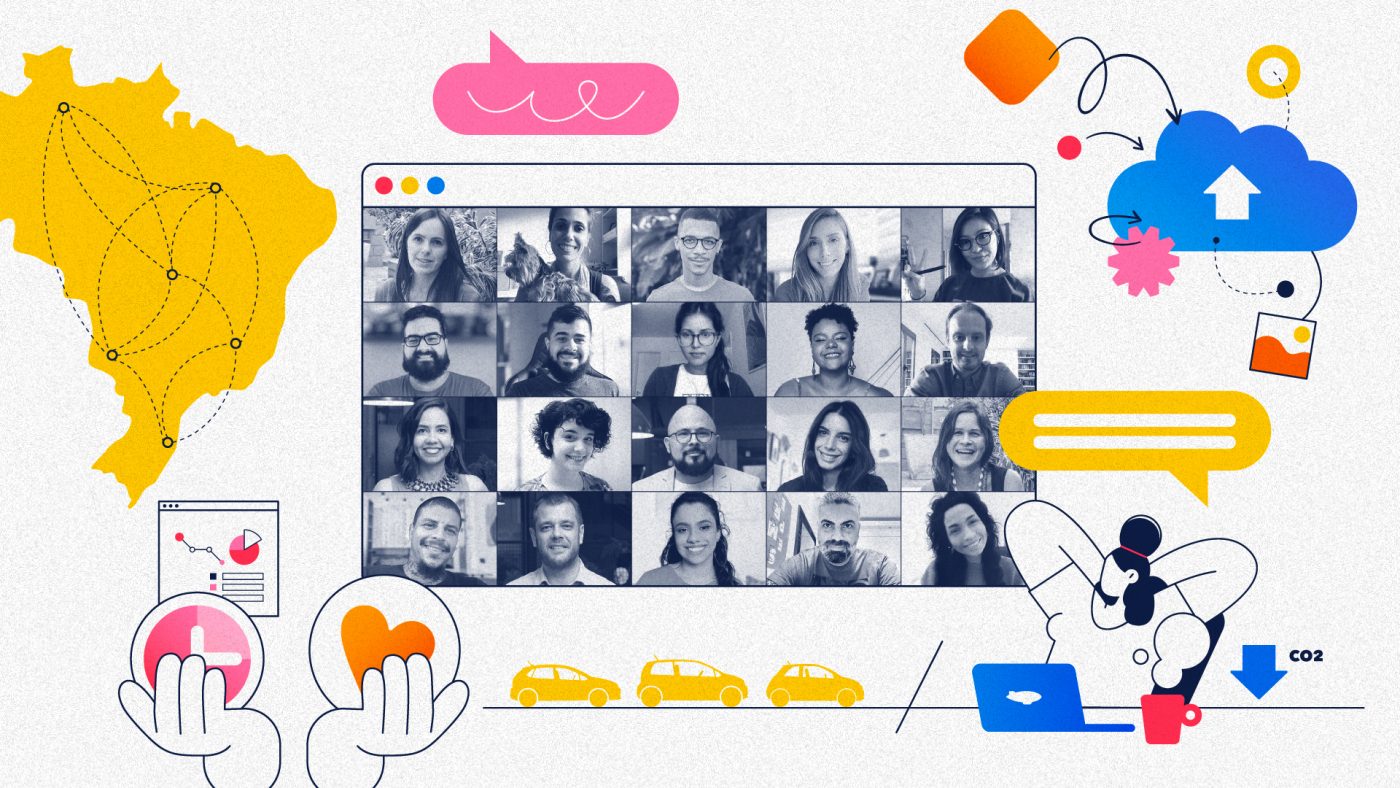Since August 2021, CBA B+G has been officially remote first. While many businesses are eager to resume face-to-face interactions, we believe that the future of successful organizations lies in adopting an essentially remote model and adapting to the digital processes inherent in this choice.

"We weren't prepared for the remote model."
Since 2008, CBA B+G had been operating in a former warehouse on Rua Álvaro Rodrigues in the district of Brooklin, in São Paulo. The place perfectly matched us: it was an inviting space for teamwork, full of green areas and environments designed for collaboration, co-creation, and prototyping. We had created a very special environment over the years, that was loved and desired by everyone who had ever been there – employees, customers, or business partners.
In March 2020, the pandemic landed in Brazil. Like so many other companies, we had to adapt to the urgency of remote work to maintain the safety of each of the then-eighty employees. It wasn’t easy, we weren’t prepared. Almost nothing was in the cloud; we relied on a local server and heavy, immutable working tools. Many designers and production professionals had to take home their computers, mostly desktops, in a hurry. Chairs, ergonomic supports, monitors, and personal items had to be packed, and in addition to the logistic struggle, leaving our comfortable and beloved shed so abruptly felt as if a piece of our identity as CBA B+G had been ripped away.
We entered 2021 with many restrictions on social interaction, so we were forced to stick with the remote model. We noticed that companies of all sizes around the world were permanently adopting the hybrid or remote model. We realized it was a one-way path. Even after the end of the pandemic, the attitude toward work and productivity in organizations would never be the same. We chose the remote first model and said goodbye to the space we occupied, knowing that, of all the scenarios, the physical no longer had adherence to the new reality of work relationships, and the hybrid would be a potential combination of the worst of both worlds, preventing the cultural turn that we so desperately needed. It was not an easy decision, but I am confident that we made the right choice, a choice that contributed to ensuring the sustainability and success of our organization in the long term.
"Being remote first requires reviewing metrics, behaviors, communication, and mindsets."
The remote first culture doesn’t happen overnight. It needs to be built. In a few months, we had to set up an office in the cloud, acquire new communication habits and tools in a remote work environment, learn remote project management skills, and build connection and trust without the help of a physical space. To put this into practice, it was necessary to review our metrics, behaviors, communication, and mindsets.
- Changing metrics: Our corporate culture has always taught us to use time as a KPI to measure results and productivity. But the truth is that few employees work 8 or 9 hours a day. We have to invest energy in focusing more on the results we want to achieve and less on time.
- Changing behaviors: We must encourage more proactive behaviors that promote transparency, accessibility, and the dissemination of up-to-date and contextualized information. Understanding that collaboration occurs not only through co-creation, but that documentation serves as the foundation of a collaborative ecosystem
- Changing Communication: The remote first model suggests that all communication should, whenever possible, be done asynchronously (chats, discussion forums, videos, and emails), respecting each one’s schedule. Efficient asynchrony prevents interruptions, and moments of urgency become increasingly rare. Furthermore, documentation—the foundation of asynchronous discussions—is liberating and allows access to discussions, creating history and redeemable intelligence for current and future use, allowing the contextualization of new people at any time, and replacing the monopoly of individualized information with the concept of the shared legacy of information.
- Changing the mindset: the remote first mindset is based on the idea of having transparent information available anytime and anywhere. Considering the same level of governance, decisions cannot be made without the participation or knowledge of all. And there can be no favoritism in relation to those who are present in person or in synchronous discussions, such as videoconferences, without the agenda and decisions being shared with their peers.
The biggest cultural challenge is maintaining people's emotional connection
In addition to the structural challenges, we face an even greater cultural challenge. No matter how well a group of people works remotely, they miss getting together outside business meetings: bumping into each other in corridors, having coffee together, or celebrating birthdays. This is both natural and human. We recognize the importance of maintaining and nurturing this type of human connection, which is why we created our Get Together – in-person bonding events held every three months. Furthermore, by establishing a strong Culture and People department and improving the Communication department, we enhanced listening and increased the frequency and quality of content aimed at internal audiences. We also provide the benefit of a coworking network with over 1600 workspaces throughout Brazil to encourage meetings between teams that are in the same city.

Advantages of the remote first model
In a couple of years, our way of working evolved for the equivalent of a decade. Today, I see major positive changes:
- Higher productive quality: data from our internal research shows that our employees are more productive working from home, partly because they have more control over their work environment and can avoid distractions. Furthermore, working in the cloud and with appropriate digital tools frees up time for project and information management.
- Greater adaptability and inclusion: today, we adapt to customer needs and profiles, and we can organize and facilitate a co-creation workshop or a panel of consumers both online and in person with the same remote first mindset: documenting everything in the cloud and providing the same level of access to information and attention, synchronously to those who are present (online or physically) or asynchronously to those who are not.
- Greater flexibility, quality of life, and economy: employees who work remotely have more control over their work schedule and can better balance their professional and personal responsibilities. They can sometimes gain up to four hours a day that would have been lost in traffic as well as save money on transportation, food, and other work-related expenses.
- Greater diversity: remote working has allowed us to hire people from all over Brazil – from São Paulo to Manaus, through Brasilia, Rio de Janeiro, and Salvador; the CBA B+Gs are increasingly spread across the country, ensuring greater diversity and inclusion.
- Lower environmental impact: remote working has reduced the need for travel and commuting, which has helped us reduce greenhouse gas emissions and other negative environmental impacts and therefore meet our ESG targets until 2030.
I am proud and confident in our choice of business model. Today’s CBA B+G is more agile, diverse, and collaborative than ever before, and there is still enormous room for collective improvement ahead. Want to join us? Click here! Or if you would like to work with us on a project, come this way.
_
Luis Bartolomei

